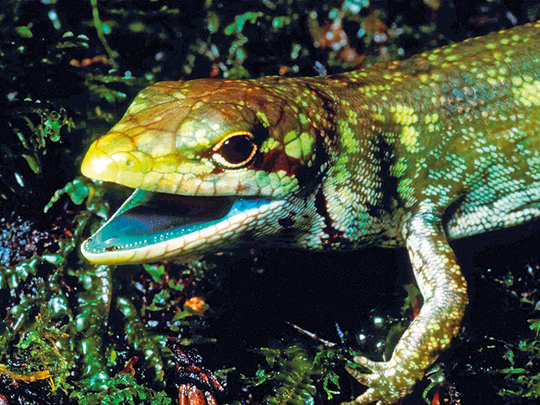
Washington: A group of lizards inhabiting the island of New Guinea boasts one of the most exotic traits of any animal: green blood.
And scientists have been trying hard to figure out what benefit this characteristic — caused by high levels of an ordinarily toxic green bile pigment — may give them.
But these lizards are beginning to give up some of their secrets, including their evolutionary history. Researchers said on Wednesday a DNA study resolved their family tree, finding that green-bloodedness evolved four different times among lizards called skinks on New Guinea.
“Our key finding was that green-blooded lizards are not each other’s closest relatives, and they all likely evolved from an ancestor that had red blood. This means that green blood likely emerged independently in different lizards, suggesting that green blood has beneficial properties,” said evolutionary biologist Zachary Rodriguez of Louisiana State University’s Museum of Natural Science.
The high blood concentration of the green bile pigment biliverdin overwhelms the intense crimson colour of red blood cells, resulting in a striking lime-green colouration of their blood, muscles, bones and mucosal tissues, said LSU biologist Christopher Austin, a curator at the museum.
High levels of biliverdin cause jaundice in most animals.
But these lizards thrive despite biliverdin levels many times greater than the lethal concentration in people.
Scientists remain uncertain about the advantage green blood may provide the lizards. Several fish, frog and insect species also are green-blooded.
“Our current hypothesis is that this novel and toxic physiology might have evolved to reduce or preclude the infection of blood parasites such as malaria,” Austin said.
The researchers examined DNA from the six green-blooded lizard species and 45 closely related red-blooded species. They are now looking into the genes responsible for green-bloodedness, hoping an understanding of the genetic factors that let these lizards remain jaundice-free may lead to a cure for jaundice.
The green-blooded lizards, up to a foot (30cm) long, live in lowland tropical forests and highlands on New Guinea, an island shared by Papua New Guinea and Indonesia.
“Oh, these animals are gorgeous, truly some of the most beautiful and enigmatic lizards in the world, living on one of the most megadiverse islands on the planet,” Austin said.
“They have other cool traits such as giving birth to live young and adhesive toe pads,” Rodriguez added.
The research was published in the journal Science Advances.












